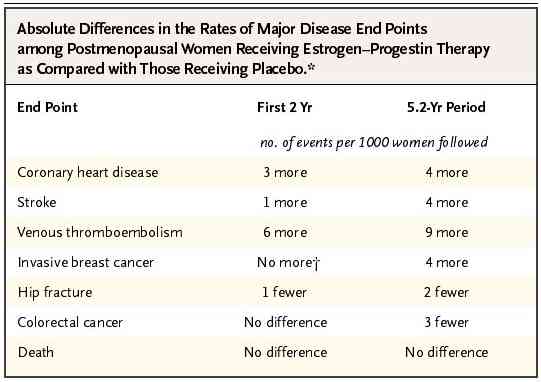| This does not mean that postmenopausal hormone therapy should never
be used. Postmenopausal symptoms — such as hot flashes and vaginal dryness
or discomfort — remain a valid indication in the absence of
contraindications such as a history of venous thromboembolism or coronary
disease. For symptoms of genital atrophy alone, local estrogen or nonhormonal
lubricants may be sufficient and should be considered. Although there are other
possible treatments for vasomotor symptoms — for example, selective
serotonin-reuptake inhibitors — hormone therapy is very effective and
still reasonable as first-line treatment. Because vasomotor symptoms are
generally transient, short-term use (for no more than two to three years) is
all that is generally needed, and such use carries few risks. Using the minimal
dose of estrogen that controls symptoms (e.g., 0.3 mg rather than 0.625
mg of conjugated estrogen) makes sense, although there are no long-term data
indicating that a lower dose reduces risk.
What about women who are using postmenopausal estrogen–progestin therapy
for reasons other than control of symptoms? On the basis of available data,
these women should be advised to stop. Long-term use cannot routinely be
encouraged for the protection of bone, given the availability of alternative
therapies, and there are no data from large clinical trials to support the
belief that long-term therapy will help women preserve cognitive function or
maintain a youthful appearance.
That said, there is no urgency to stop hormone therapy abruptly. In women
whose symptoms recur after stopping, therapy can be gradually tapered (by
reducing the frequency of administration, the dose, or both) over a period of
weeks to months. For a small number of women — those with persistent
symptoms and reduced quality of life — continued treatment may be
justified, as long as they understand the potential risks and the alternatives.
The findings of the WHI and other trials do not rule out the possibility
that some postmenopausal women might derive cardiovascular benefit from hormone
therapy. Nonetheless, our current ability to identify "good
candidates" for hormone therapy is too rudimentary to support differential
prescribing. Thus, the prudent approach is to avoid hormone therapy for the
purpose of long-term prevention of disease.
The WHI findings have led some younger women who use oral contraceptives or
who use hormone therapy after premature menopause to wonder whether they should
stop. Studies of hormone therapy in women 50 years of age or older, however,
cannot be generalized to these groups.
In response to the WHI, other hormonal regimens or preparations have been
touted as alternatives to conjugated estrogen with medroxyprogesterone.
Estrogen therapy alone (without a progestin) is not recommended unless a woman
has had a hysterectomy, because it is associated with increased risks of
endometrial hyperplasia and cancer. More information about the long-term
effects of estrogen alone after hysterectomy should be forthcoming from an
ongoing part of the WHI study. Different formulations (including "natural"
estrogens or progesterone) or transdermal administration has also been
suggested. However, their long-term effects have simply not been studied. On
the basis of available data, the Food and Drug Administration recently
recommended that labeling for all postmenopausal estrogen and
estrogen–progestin products include a boxed warning emphasizing the
associated risks of coronary disease, stroke, and breast cancer.
What should postmenopausal women do now? Women older than 65 years of age or
younger women with other risk factors for osteoporosis should have their bone
mineral density measured. Women should routinely be advised to consume adequate
calcium and vitamin D and to engage in weight-bearing exercise. For women who
have osteoporosis, the bisphosphonates alendronate and risedronate substantially
reduce the risk of both hip and vertebral fractures. The selective
estrogen-receptor modulator raloxifene also reduces the risk of vertebral
fracture, although it has not been shown to reduce the risk of hip fracture. In
contrast to estrogen, it appears to reduce the risk of invasive breast cancer
but does not improve (and may cause) menopausal symptoms. Raloxifene also
increases the risk of venous thromboembolism, although its effects on
cardiovascular disease remain uncertain.
To reduce cardiovascular risk, coronary risk factors should be assessed,
including reevaluation of the lipid profile, which may worsen after the
cessation of hormone therapy. A healthful diet, exercise, and smoking cessation
should be encouraged; medications including statins and antihypertensive agents
should be used in appropriate patients. The combination of these approaches
is much more likely than estrogen–progestin therapy to optimize
health and longevity in postmenopausal women. |
